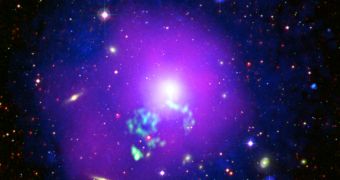Astronomers with the European Space Agency (ESA) have recently conducted a new study of the NGC 5054 cosmic cluster, a formation named after the most massive galaxy it contains. The work revealed significant new insight into why the cosmic gas in this structure is so luminous.
For this investigation, scientists used data from the ESA XMM-Newton X-ray Observatory, a telescope launched into space on December 10, 1999 to investigate the high energy Universe. The instrument has thus far spent nearly 14 years in a high-eccentricity orbit around our planet.
Its latest image shows the NGC 5054 galactic cluster in several bands of X-rays. Additional data in the photo were collected by the NASA Wide-field Infrared Survey Explorer (WISE) and Spitzer Space Telescope (in infrared), as well as by the Digitized Sky Survey (optical).
The cluster it depicts is concentrated around the massive elliptical galaxy NGC 5054. This object is surrounded by a large number of small galaxies and dwarf galaxies, and is currently passing through a huge molecular cloud in space. The diffuse gas in the clouds is extremely hot.
XMM-Newton was able to observe this structure because gas superheated at 10 million degrees produces X-rays, one of the most energetic types of light in the Universe. Thanks to the new observations, astrophysicists were able to determine that the gas in NGC 5954's path is being jumbled.
This is the main reason for the creation of the lob-sided shapes visible in the new data set. Among the hot gas clouds, researchers also uncovered a type of very energetic plasma, which may have been produced long ago by a supermassive black hole at the core of the elliptical galaxy.
The plasma is revealed as the green filaments extending downwards for the center of the cluster in this image. Its existence was confirmed by the Giant Metrewave Radio Telescope, in India.
At the same time, the Newton data enabled scientists with the research team to map the distribution of iron atoms around the galaxy cluster. These atoms appear in purple in the new image, and it is very easy to see that they permeate the entire cluster, as well as its vicinity.
The ESA telescope also shows the distribution of intergalactic gas in the cluster. There are two main bubbles visible, one in the center and upper left portions of the image, and another in the lower right.
At this point, the galactic cluster focused around NGC 5054 is not inside the massive gas halo, but lies somewhere to the lower left, outside of Newton's field of view. Scientists now believe that the reason why this gas is so luminous is that it was mixed and swirled as the galaxy passed through it very fast.

 14 DAY TRIAL //
14 DAY TRIAL //